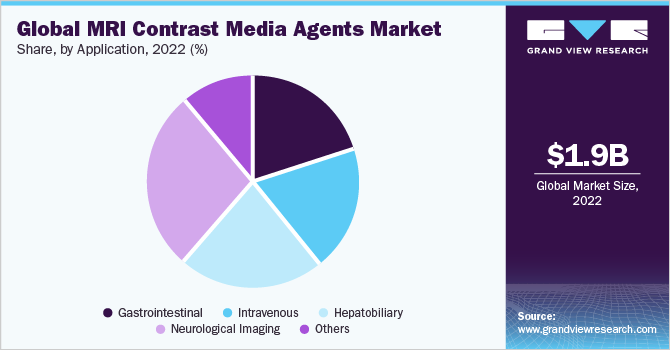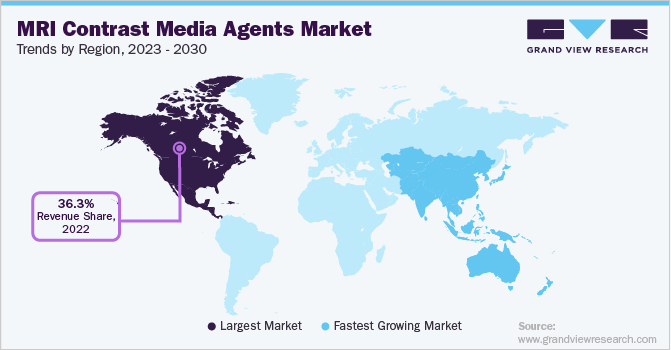- Home
- »
- Medical Devices
- »
-
MRI Contrast Media Agents Market Size & Share Report, 2030GVR Report cover
![MRI Contrast Media Agents Market Size, Share & Trends Report]()
MRI Contrast Media Agents Market (2024 - 2030) Size, Share & Trends Analysis Report By Product (Paramagnetic Agents, Superparamagnetic Agents), By Application, By End-use, By Type, By Region, And Segment Forecasts
- Report ID: GVR-4-68039-973-0
- Number of Report Pages: 110
- Format: PDF
- Historical Range: 2018 - 2022
- Forecast Period: 2024 - 2030
- Industry: Healthcare
- Report Summary
- Table of Contents
- Segmentation
- Methodology
- Download FREE Sample
-
Download Sample Report
Report Overview
The global MRI contrast media agents market size was valued at USD 2.11 billion in 2023 and is expected to expand at a compound annual growth rate (CAGR) of 7.2% from 2024 to 2030. MRI contrast media agents are widely used to identify the presence of tumors, aneurysms, and other tissue abnormalities. This market holds a high growth potential due to the enormous research and development in this space to develop contrast media agents with reduced ill effects, minimized the occurrence of adverse reactions, minimal dosing, and improve imaging efficacy.

These agents have the dynamics to identify the progressions of brain tumor, liver cancer, or breast cancer and establish improved guidance during surgical intervention. Contrast media-enhanced MRI procedures are likely to increase in the future as the application of MRI expands and as the information obtained from a single contrast injection increases. However, variation in practice by end-users, calls for greater standardization of protocols and utilization of the latest diagnostic algorithms.
There has been a significant increase in participation in sports in the last decade. Thus, the incidence of sports injuries is rapidly increasing. For instance, as per Johns Hopkins Medicine, around 30.0 million children & teens participate in sports and around 3.5 million sports injuries occur every year. Similarly, as per the Association for Safe International Road Travel, around 20 to 50 million people are injured or disabled due to road accidents. Thus, a surge in the number of sports and trauma injuries is boosting the demand for MRI contrast media agents.
Product Insights
Based on product, the market is segmented into paramagnetic agents and superparamagnetic agents. The primary class of paramagnetic contrast agents is gadolinium-based contrast agents. Others include ferric ammonium citrate and manganese-based contrast agents. Gadolinium agents are the only ones that have grown into a realistic market size.
These elements shorten the T1 or T2 relaxation time, thereby causing increased signal intensity on T1-weighted images or reduced signal intensity on T2-weighted images. Most paramagnetic contrast agents are positive agents. These agents shorten the T1, so the enhanced parts appear bright on T1-weighted images. Ferumoxides, ferucarbotran, ferumoxtran-10, iron oxide-based agents, and many others are examples of this category. The highly researched superparamagnetic agent includes Superparamagnetic Iron Oxide Nanoparticles (SPIONs). However, they hold the disadvantage of being easily uptaken by macrophages.
End-use Insights
Hospitals accounted for the largest market share in 2022. Hospitals are the go-to centers for all patients seeking major diagnostic tests. All chronic illnesses are treated in hospitals, which explains their high market share. Additionally, the number of research activities conducted by hospitals and the economy and infrastructure needed to buy and store these agents, are only available at the hospital end. Thus, they account for the larger market size.
The imaging centers segment is expected to experience the fastest growth rate during the forecast period. Growing demand for non-invasive diagnosis is encouraging the emergence of numerous specialized facilities that may offer services like MRI. These centers are constantly looking to adopt high-end and exceptional-quality MRI and contrast agents to improve their customer base. Thus, it is anticipated to drive the segment growth in the projected period.
Type Insights
MRI contrast agents are further segmented into the clinical and preclinical markets, where clinical accounted for the largest revenue share in 2022. Many contrast agents have been created for use in clinical practice over the past three decades, and some of them have been removed due to safety issues. Contrast MRI agents are divided into a number of classes, based on factors such as chemical makeup, magnetic field, route of administration, presence of metal atoms, characteristics, picture-related effects, biodistribution, and more. There are constant variations in the clinical compositions, action mechanisms, safety, pharmacokinetics, and pharmacodynamics.
Numerous studies are taking place to develop newer contrast agents. For instance, in 2021, the U.S. Food and Drug Administration approved the first human clinical trials to test the safety of cancer-detection technology developed at Case Western Reserve University. It is a tumor-targeting contrast agent that accurately detects aggressive prostate cancer in a magnetic resonance imaging (MRI) scan. Numerous companies are developing MRI contrast agents that are still in the preclinical trial phase. Some of them include Reveal Pharma and Miltenyi Biotec B.V. & Co. Kg.
Application Insights
Based on application, the MRI contrast media agents industry is segmented into gastrointestinal, intravenous, hepatobiliary, neurological imaging, and others. MRI systems used for neurological imaging held the largest market share in 2022 as scans produced were of superior quality than those by computerized tomography scans. The primary aim of these contrast agents is to identify target organs and specific tissues. Most gadolinium and ferumoxides agents, enhance and showcase the physiochemical effects of liver.

Nearly 30 million MRI scans are conducted yearly in the U.S. Studies suggest that gadoxetic acid-enhanced liver MRI is an evolving technique with the potential for non-invasive quantification of liver function and staging of hepatic fibrosis. Gastrointestinal MRI contrast agents may be helpful in certain clinical scenarios in distinguishing the bowel from intra-abdominal masses and normal organs. Combinations of oil emulsion and paramagnetic substances may be used as bowel contrast agents. These ludes an emulsion-containing corn oil and ferric ammonium citrate. These are palatable mixtures that distribute uniformly in the bowel.
Regional Insights
North America dominated the global market in 2022 with a revenue share of over 36.31%. The increasing incidence of chronic diseases in this region, which includes breast cancer, cardiology, and neurological diseases is creating a demand for imaging analysis. The region is expected to maintain its dominance throughout the forecast period. Technological innovations coupled with the growing incidence of chronic conditions are anticipated to spur growth during the forecast period.

Asia Pacific is expected to exhibit the fastest CAGR during the forecast period due to the increasing geriatric population and growing demand for advanced imaging modalities. Moreover, the growing medical tourism industry in Asian countries is anticipated to augment the advanced medical imaging industry’s growth during the forecast period. Countries such as India, China, and Japan are creating growth opportunities with rapidly expanding healthcare service industry, the presence of skilled healthcare staff, and advanced healthcare facilities and services at a lower cost than developed countries.
Key Companies & Market Share Insights
The key players are focusing on getting various regulatory agencies approvals for expanding their product portfolio of MRI contrast agents around the world. For instance,
-
Bayer AG in July 2019, announced the FDA approval of Gadavist. It is a gadobutrol contrast agent for cardiac MRI for the detection and monitoring of coronary artery disease.
-
In November 2019, GE Healthcare announced the FDA approval of their MRI contrast agent Clariscan. It is a gadolinium-based, macrocyclic, contrast agent used to visualize the disruption of the blood-brain barrier or any abnormality in both adult and pediatric patients.
Some prominent players in the global MRI contrast media agent market include:
-
GE Healthcare
-
Bayer AG
-
Guerbet GmbH
-
Bracco Imaging Spa
-
Vitalquan, LLC
-
Miltenyi Biotec B.V. & Co. Kg
MRI Contrast Media Agents Market Report Scope
Report Attribute
Details
Market size value in 2024
USD 2.24 billion
Revenue forecast in 2030
USD 3.42 billion
Growth Rate
CAGR of 7.2% from 2024 To 2030
Base year for estimation
2023
Historical data
2018 - 2022
Forecast period
2024 - 2030
Quantitative units
Revenue in USD million and CAGR from 2024 to 2030
Report coverage
Revenue forecast, company ranking, competitive landscape, growth factors, and trends
Segments covered
Product, type, application, end-use, region
Regional scope
North America; Europe; Asia Pacific; Latin America; MEA
Country scope
U.S.; Canada; U.K.; Germany; Italy; France; Spain; Norway; Sweden; Denmark; China; India; Japan; South Korea; Thailand; Australia; Mexico; Brazil; Argentina; Saudi Arabia; South Africa; UAE; Kuwait
Key companies profiled
GE Healthcare; Bayer AG; Guerbet GmbH; Bracco Imaging Spa; Vitalquan, LLC; Miltenyi Biotec B.V. & Co. Kg
Customization scope
Free report customization (equivalent up to 8 analyst’s working days) with purchase. Addition or alteration to country, regional & segment scope
Pricing and purchase options
Avail customized purchase options to meet your exact research needs. Explore purchase options
Global MRI Contrast Media Agents Market Segmentation
This report forecasts revenue growth at global, regional & country levels and provides an analysis of the latest industry trends in each of the sub-segments from 2018 to 2030. For this study, Grand View Research has segmented the global MRI contrast media agents market report based on product, type, application, end-use, and region:
-
Product Outlook (Revenue, USD Million, 2018 - 2030)
-
Paramagnetic Agents
-
Superparamagnetic Agents
-
-
Type Outlook (Revenue, USD Million, 2018 - 2030)
-
Clinical
-
Preclinical
-
-
Application Outlook (Revenue, USD Million, 2018 - 2030)
-
Gastrointestinal,
-
Intravenous
-
Hepatobiliary
-
Neurological Imaging
-
Others
-
-
End-use Outlook (Revenue, USD Million, 2018 - 2030)
-
Hospitals
-
Imaging Centers
-
-
Regional Outlook (Revenue, USD Million, 2018 - 2030)
-
North America
-
U.S.
-
Canada
-
-
Europe
-
U.K.
-
Germany
-
Italy
-
France
-
Spain
-
Norway
-
Sweden
-
Denmark
-
-
Asia Pacific
-
India
-
China
-
Japan
-
South Korea
-
Australia
-
Thailand
-
-
Latin America
-
Brazil
-
Mexico
-
Argentina
-
-
Middle East & Africa
-
South Africa
-
Saudi Arabia
-
UAE
-
Kuwait
-
-
Frequently Asked Questions About This Report
b. The global MRI contrast media agents market size was estimated at USD 1.98 billion in 2022 and is expected to reach USD 2.10 billion in 2023.
b. The MRI contrast media agents market is expected to grow at a compound annual growth rate of 7.15% from 2023 to 2030 to reach USD 3.41 billion by 2030.
b. North America dominated the global market MRI contrast media agents market in 2021. The increasing incidence of chronic diseases in this region, which includes breast cancer, cardiology and neurological diseases is creating a demand for imaging analysis.
b. Some of the prominent players in the MRI contrast media agent market include GE Healthcare, Bayer AG, Guerbet GmbH, Bracco Imaging Spa, Vitalquan, LLC, and Miltenyi Biotec B.V. & Co. Kg
b. The factors anticipated to propel market growth include the rising prevalence of chronic diseases and the rising demand for early diagnosis.
Share this report with your colleague or friend.
Need a Tailored Report?
Customize this report to your needs — add regions, segments, or data points, with 20% free customization.

ISO 9001:2015 & 27001:2022 Certified
We are GDPR and CCPA compliant! Your transaction & personal information is safe and secure. For more details, please read our privacy policy.
Trusted market insights - try a free sample
See how our reports are structured and why industry leaders rely on Grand View Research. Get a free sample or ask us to tailor this report to your needs.










